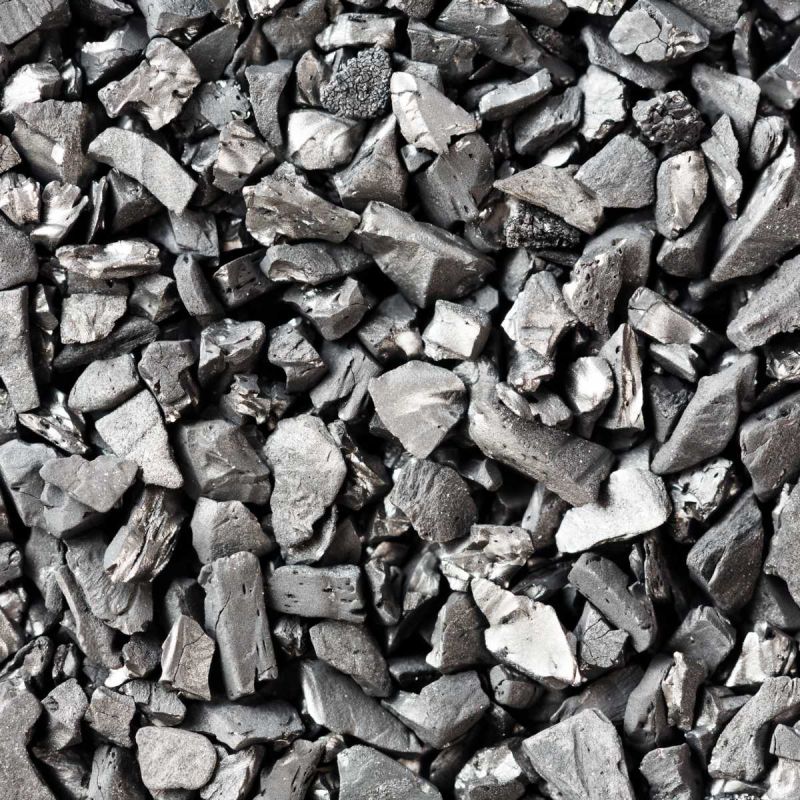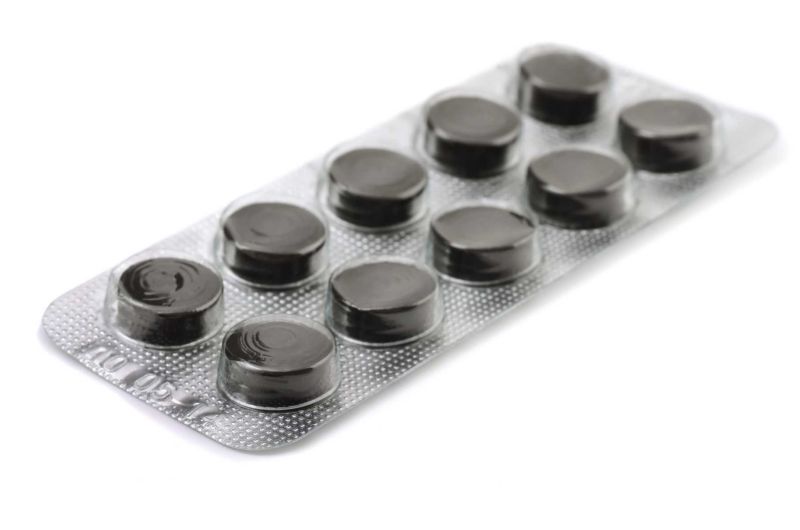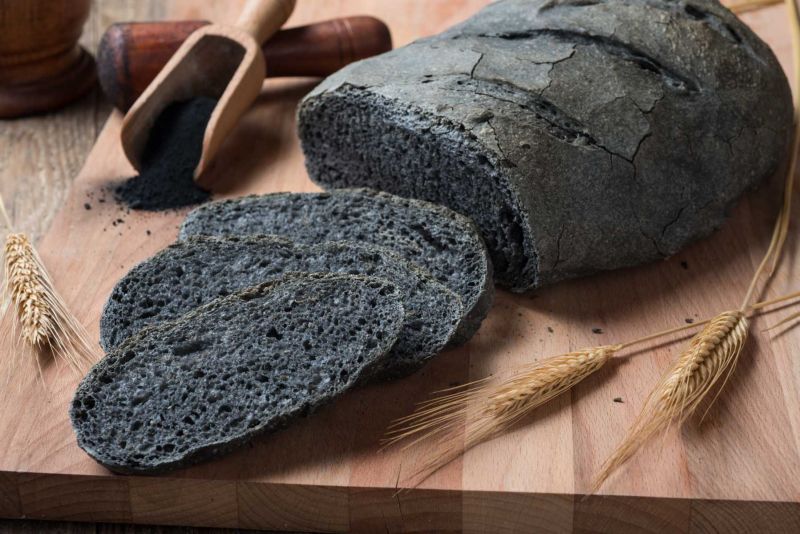Activated charcoal - application and background
What exactly is activated charcoal?
Activated carbon is a highly porous, dust-fine, sponge-like carbon with an immensely large inner surface area.
The inner surface and its porous structure for adsorption (i.e. adhesion to the surface) predestine the activated carbon to remove unwanted substances from vapors or liquids.
Activated carbon is used to filter out heavy metals such as lead, zinc, copper, nickel and cadmium.
Chlorine, pesticides, trihalomethanes, drug residues, hormones, odors, colors and flavors are also removed. This is why it is not only used in wastewater and drinking water treatment,
but also in medicine, cosmetics, chemicals and in ventilation and air-conditioning technology.
How is activated charcoal produced?
Activated carbon is made from several carbonaceous materials, such as peat, wood, bone, lignite, coal and coconut shells.
(Acala water filters use high-tech activated carbon made from coconut shells)
First, the starting material is carbonized at 800°C. The material is then subjected to a manufacturing process that creates an extremely large inner surface, the so-called “activation” (hence the name “activated carbon”).

Incredibly large surface area of activated carbon
The internal surface area of just 1 g of starting coal is approx. 10m2.
After activation, 1 g of activated carbon, e.g. from coconut shell, can have an internal surface area of 1000m2 or more.
By unfolding about four to five grams (approx. 1 teaspoon) of activated charcoal, you could theoretically cover the entire surface of a soccer pitch.
Activating the activated carbon
Activation takes place at temperatures of 700 – 1000 °C using water vapor and carbon dioxide, in some cases also with air.
During this activation, part of the carbon is converted into carbon dioxide, creating additional pores and increasing the surface area.
A distinction is made between chemical activation and gas activation. Chemical activation involves treating a mixture of uncharred starting material with chemicals,
mainly with dehydrating agents, e.g. Zinc chloride or phosphoric acid, at temperatures of 500 – 900 °C.
During gas activation, materials that have already been carbonized, such as. Charcoal, peat coke, coconut shell coke, hard coal or lignite are used as raw materials.
Types of activated carbon
There are three types of activated carbon: powdered, granular and molded.
In the case of grain charcoal, the particles have a size of approx. 1 mm, whereas in the case of powder
the size is approx. 0.1 mm.
In both cases, the inner surface area is the same. In the case of molded carbon, the carbonized semi-finished product is pulverized, activated and then mixed with adhesive and extruded or sintered as required.
One challenge when using molded carbon is that water pressure is required to allow the water to flow through the activated carbon, as the adhesive blocks the water flow.

Molded/glued carbon
It is immensely more efficient to use grain charcoal where gravity alone is sufficient to cause the flow.
This gives the water the opportunity to develop naturally.
This type of activated carbon is used in Acala water filters.
The size of the particles can also influence the speed of adsorption,
but not the adsorbed quantity, as this only depends on the inner surface.
Structure of the atoms
Activation gives the activated carbon an irregular, disordered crystalline structure of carbon atoms.
This disordered structure has a high porosity where the substances to be filtered can be bound.
These pores are classified according to their size: Macropores (> 50 nm*), mesopores (2-50 nm*), micropores (1-2 nm) and minimicropores (< 1 nm*).
Micropores are suitable for smaller molecules. Coconut shell charcoal has a larger inner surface area and a greater proportion of micropores.
*(1 nm (nanometer) is one millionth of a millimeter)
Retention capacity of the activated carbon
The extent to which activated carbon adsorbs a substance depends on several factors, e.g. the size of the molecules, the solubility of the substance, its affinity for activated carbon,
or the pH value of the water, which influences these variables.
Activated carbon is particularly suitable for removing organic substances such as trihalomethanes, pesticides and hormones, as these have a higher binding affinity to activated carbon.
Can activated charcoal filter out microplastics or nanoplastics?
Plastic particles can also be classified according to their size.
They are generally known as microplastics, but are also given different names according to their size. Mesoplastics (500 µm* – 5 mm), microplastics (50 µm* – 500 µm*)
and nanoplastics with a size of less than 50 µm* (some authors set the limit at 100 nm**). Although they are referred to as nanoplastics, their size is actually larger than 1 nm**
The formation of nanoplastics from microplastics depends primarily on the time factor.
It has been estimated that 320 years are required,
to turn a 1 mm microplastic into a 100 nm nanoplastic.
In addition, a group of scientists investigated the clumping of 30 nm** polystyrene particles (a type of plastic) in seawater and found a rapid formation of 1000 nm** aggregates within 16 minutes.
So it seems that even when nanoplastic particles are in the water, they tend to clump together to form particles of microplastics.
So the question is: can activated charcoal filter out microplastics? The answer is a resounding yes.
It should be clear that the nanopores with a size of less than 2 nm** adsorb the larger particles such as mesoplastics and microplastics.
This is also the case with nanoplastics; only in extreme cases of nanoplastic particles with a size of less than 2 nm** could these particles pass through the pores.
The filtration of microplastic particles by activated carbon is therefore guaranteed in almost all cases.
In addition, plastic is not dissolved in water, so it can be assumed that it is hydrophobic and feels more comfortable on the carbon or in the carbon than in water.
Plastic is organic and therefore has an increased affinity for activated carbon.
Why is plastic organic?
Organic molecules are complex compounds that contain carbon and other elements. Plastics are polymers, which are chain molecules. The organic component of plastic refers to the carbon which, depending on the type of plastic, occurs together with hydrogen, oxygen, sulphur and nitrogen.

Activated charcoal unhealthy?
You should not worry,
that your water comes into contact with activated carbon.
Activated charcoal is a natural product,
especially when it is made from coconut shells.
You get the same activated charcoal from your family doctor if you have diarrhea.

Charcoal is even used to color ice cream and other foods.
Charcoal has many different areas of application, and its excellent properties are also used in cosmetics to benefit the skin.
This ensures your health and protects the water and the environment.



Historical facts:
The use of activated carbon in its current form has only a short history.
However, coal, mostly in the form of charcoal, was already used in ancient times by the Egyptians, Indians, Greeks and Romans.
In Egypt, for example, it was used for embalming the deceased and for sealing the hulls of ships.
The ancient Greeks used charcoal as an antidote to food poisoning.
It was first used for drinking water treatment in India, as a Sanskrit text from around 200 BC reports.
In the 15th century, during the time of Christopher Columbus, sailors discovered that drinking water stays fresh longer during sea voyages if the wooden containers are “charred” on the inside.
The first scientific study on activated charcoal was carried out by Karl Wilhelm Scheele, a Swedish chemist, at the end of the 18th century.
The first industrial application took place at the beginning of the 20th century.
